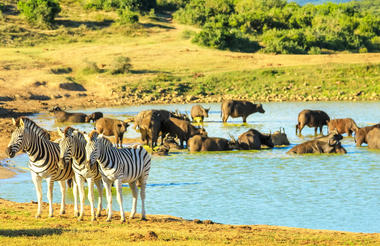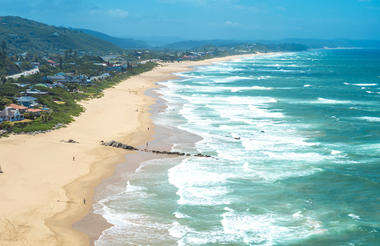We leave the mayhem of suburbia far behind us as we head northward into the limitless expanses of the Great Karoo. This is a harsh land, arid, wind-swept and largely devoid of human settlement. Here, plants and animals have developed specialised adaptations to survive searing summer temperatures and sub-zero winters, and the many windmills that dot the landscape are mute testimony to man's endless quest for water.
Soon the white turrets of Matjiesfontein’s Lord Milner Hotel come into view, and we stop here for lunch before continuing our journey to Karoo National Park - our home for one night. We settle in to our comfortable chalets, and relax for a while before sampling Karoo cuisine at dinner in the cosy and congenial restaurant. Karoo National Park is situated on the edge of the Cape Escarpment, and its mountains and plains provide ideal habitats for a wide diversity of endemic wildlife, ranging from reintroduced lion and black rhino to the rare riverine rabbit. Springbok, red hartebeest, Cape mountain zebra and many more species are encountered on game drives, and the Fossil Trail provides a window into the prehistory of the region.
We take a drive up the Klipspringer Pass, constructed in the "dry stone retaining wall" technique which was perfected by Thomas Bain - doyen of South African pass builders. All the rocks used in the pass construction were taken from farms outside the park, adding further substance to the environmental ethos of SAN Parks management planning.



We head for the plains of the Camdeboo, and historic Graaff-Reinet, the 4th oldest town in South Africa. After a light lunch, we travel eastward toward the higher lying grassland of the Eastern Cape Midlands. In the late afternoon we reach Mountain Zebra National Park near Cradock, and check in at this relatively remote and less visited wildlife sanctuary. This will be our base for two nights, giving us a chance to relax and explore the various game drives available.
We set out for a game drive through the varied scenery of the park, stopping frequently to observe and enjoy sightings of local wildlife. Many endemic species find refuge here, including cheetah, buffalo and black rhino, a number of antelope and bird species, and, of course, the rare Cape mountain zebra. A breeding nucleus of lion was released into the park during 2013.



We leave the park and drive to Cradock for a light lunch at the venerable Victoria Manor complex, before turning south for Addo Elephant National Park. The landscape changes dramatically as we negotiate Olifantskop Pass, and enter the succulent Eastern Cape Valley Bushveld, so characteristic of the Addo area. We arrive at Addo in time to settle into our chalets, and then to explore the camp, browse through the curio shop or spend time at the waterhole.
We spend the next two days in the park, slowly driving through the variety of landscapes that have shaped Addo. The park has been enlarged several times during recent years and now stretches inland from the coast and its offshore islands to the high country of the Zuurberg Mountains. Addo is, of course, famous for its elephants - now well over 500 in number - and we have excellent chances of encountering one of the herds. A wide diversity of other wildlife, such as lion, buffalo, spotted hyena, black rhino red hartebeest, kudu, and many others, also find sanctuary here. We return to camp for a light lunch and some free time, before going out on an afternoon game drive. We take our time, observing animal behavior, and it is often the smaller creatures that impress one with their antics. One of Addo's keystone species is the rare flightless dung beetle, and we may observe them fashioning elephant and buffalo dung into balls to be rolled away and buried. Bird life is prolific, and many species can be viewed from close up.



Leaving Addo, we head for the Tsitsikamma Section of the Garden Route National Park. En route there is an opportunity for a walk through the indigenous forest along the eco-friendly boardwalk. There are also excellent opportunities for bird watching and identifying some of the secretive forest species, such as the brilliantly coloured Knysna Turaco (Loerie). We check into the Storms River Mouth section of the Garden Route National Park, with its dramatic coastal scenery and comfortable wooden cabins. The fit and adventurous can walk the thrilling series of suspension bridges at the river mouth. We return to our cabins for free time, to relax and enjoy the sunset over the ocean.



A short drive from Storms River is the beautiful coastal town of Wilderness. We will spend a night at the Ebb and Flow Park, where you can enjoy the varied birdlife, walks on the beach or along the river and visiting the interesting craft and coffee shops that are part of the Wilderness business center.



HOMEWARD BOUND ...
We set off westward, passing George and Mossel Bay. The scenery en-route is interesting and varied, from coastal bush to striking river and sea views. We enjoy a convivial last lunch together before heading for home through the rolling hills of the Overberg. In the late afternoon we reach our rendezvous point, where, as always, Landscape staff will be on hand to see you safely home.



